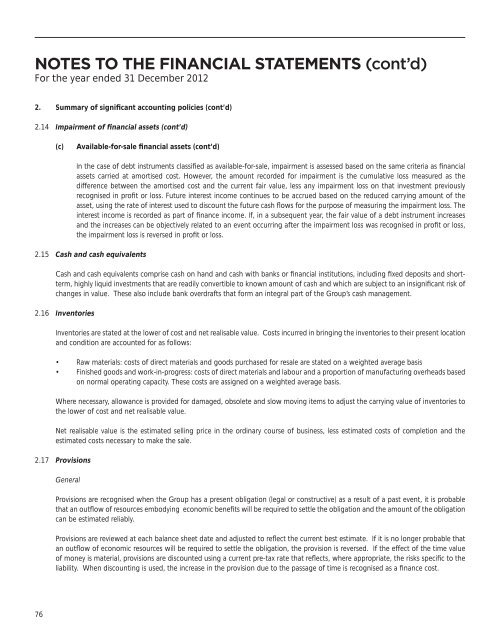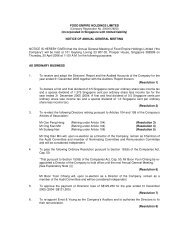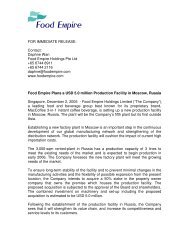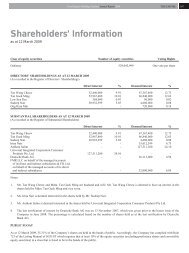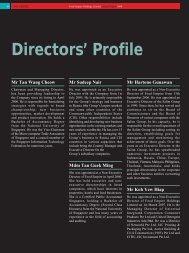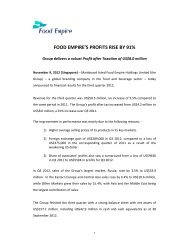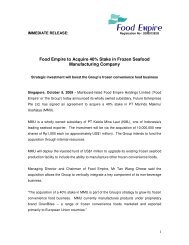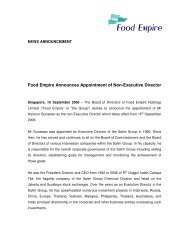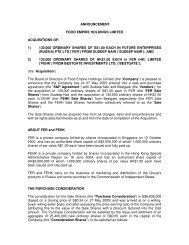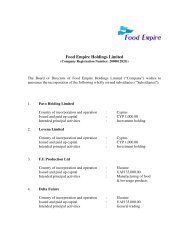notes to the financial statements - Food Empire Holdings Limited
notes to the financial statements - Food Empire Holdings Limited
notes to the financial statements - Food Empire Holdings Limited
You also want an ePaper? Increase the reach of your titles
YUMPU automatically turns print PDFs into web optimized ePapers that Google loves.
NOTES TO THE FINANCIAL STATEMENTS (cont’d)<br />
For <strong>the</strong> year ended 31 December 2012<br />
2. Summary of significant accounting policies (cont’d)<br />
2.14 Impairment of <strong>financial</strong> assets (cont’d)<br />
(c)<br />
Available-for-sale <strong>financial</strong> assets (cont’d)<br />
In <strong>the</strong> case of debt instruments classified as available-for-sale, impairment is assessed based on <strong>the</strong> same criteria as <strong>financial</strong><br />
assets carried at amortised cost. However, <strong>the</strong> amount recorded for impairment is <strong>the</strong> cumulative loss measured as <strong>the</strong><br />
difference between <strong>the</strong> amortised cost and <strong>the</strong> current fair value, less any impairment loss on that investment previously<br />
recognised in profit or loss. Future interest income continues <strong>to</strong> be accrued based on <strong>the</strong> reduced carrying amount of <strong>the</strong><br />
asset, using <strong>the</strong> rate of interest used <strong>to</strong> discount <strong>the</strong> future cash flows for <strong>the</strong> purpose of measuring <strong>the</strong> impairment loss. The<br />
interest income is recorded as part of finance income. If, in a subsequent year, <strong>the</strong> fair value of a debt instrument increases<br />
and <strong>the</strong> increases can be objectively related <strong>to</strong> an event occurring after <strong>the</strong> impairment loss was recognised in profit or loss,<br />
<strong>the</strong> impairment loss is reversed in profit or loss.<br />
2.15 Cash and cash equivalents<br />
Cash and cash equivalents comprise cash on hand and cash with banks or <strong>financial</strong> institutions, including fixed deposits and shortterm,<br />
highly liquid investments that are readily convertible <strong>to</strong> known amount of cash and which are subject <strong>to</strong> an insignificant risk of<br />
changes in value. These also include bank overdrafts that form an integral part of <strong>the</strong> Group’s cash management.<br />
2.16 Inven<strong>to</strong>ries<br />
Inven<strong>to</strong>ries are stated at <strong>the</strong> lower of cost and net realisable value. Costs incurred in bringing <strong>the</strong> inven<strong>to</strong>ries <strong>to</strong> <strong>the</strong>ir present location<br />
and condition are accounted for as follows:<br />
• Raw materials: costs of direct materials and goods purchased for resale are stated on a weighted average basis<br />
• Finished goods and work-in-progress: costs of direct materials and labour and a proportion of manufacturing overheads based<br />
on normal operating capacity. These costs are assigned on a weighted average basis.<br />
Where necessary, allowance is provided for damaged, obsolete and slow moving items <strong>to</strong> adjust <strong>the</strong> carrying value of inven<strong>to</strong>ries <strong>to</strong><br />
<strong>the</strong> lower of cost and net realisable value.<br />
Net realisable value is <strong>the</strong> estimated selling price in <strong>the</strong> ordinary course of business, less estimated costs of completion and <strong>the</strong><br />
estimated costs necessary <strong>to</strong> make <strong>the</strong> sale.<br />
2.17 Provisions<br />
General<br />
Provisions are recognised when <strong>the</strong> Group has a present obligation (legal or constructive) as a result of a past event, it is probable<br />
that an outflow of resources embodying economic benefits will be required <strong>to</strong> settle <strong>the</strong> obligation and <strong>the</strong> amount of <strong>the</strong> obligation<br />
can be estimated reliably.<br />
Provisions are reviewed at each balance sheet date and adjusted <strong>to</strong> reflect <strong>the</strong> current best estimate. If it is no longer probable that<br />
an outflow of economic resources will be required <strong>to</strong> settle <strong>the</strong> obligation, <strong>the</strong> provision is reversed. If <strong>the</strong> effect of <strong>the</strong> time value<br />
of money is material, provisions are discounted using a current pre-tax rate that reflects, where appropriate, <strong>the</strong> risks specific <strong>to</strong> <strong>the</strong><br />
liability. When discounting is used, <strong>the</strong> increase in <strong>the</strong> provision due <strong>to</strong> <strong>the</strong> passage of time is recognised as a finance cost.<br />
76


